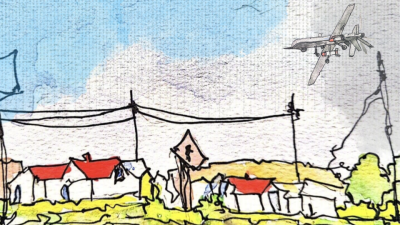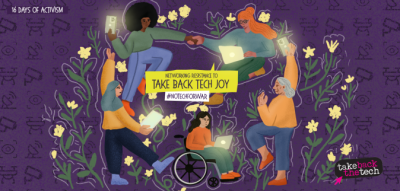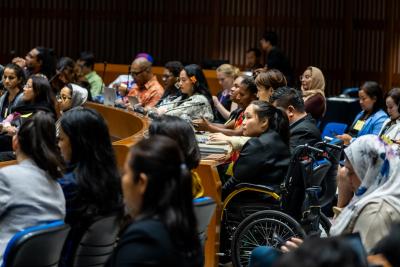
The problem
The strength of democratic institutions and legal order is strongly connected to the proaction of human rights. As many countries face challenges to their democratic and legal systems, human rights violations are increasing. However, human rights defenders (HRDs), one of the main actors who work towards the protection of human rights, are increasingly facing risks in physical, digital and legal realms, putting their lives and psychosocial safety at risk. Creating safer environments to provide greater safety, online and offline, to human rights defenders, worldwide, is essential to protect and promote democratic and human rights-based values.
As noted in a UN General Assembly landmark resolution on protection of women human rights defenders (WHRDs), “historical and structural inequalities in power relations and discrimination against women, as well as various forms of extremism, have direct implications for the status and treatment of women and [...] the rights of women human rights defenders are violated or abused and their work stigmatized.” Furthermore, state and policy responses to threats faced by HRDs are often not sensitive to gender inequalities and ignore the fact that historic structural inequalities can create systematic violations. The risk to WHRDs is thus exacerbated and they are left without crucial community support and with a legal justice system that ignores systematic discrimination.
Reports indicate “increased prevalence of online violence against women, the lack of effective measures to prevent and contain it, and the ensuing impunity.” As online violence increases, new policy challenges emerge; human rights-centric methods of corporate governance and accountability are still lacking and legislation from states is often geared towards data acquisition and control.
The evolution of digital technologies as an essential service required to operate effectively in the world today has also created new safety challenges for WHRDs. Studies note that “the internet and digital tools and spaces have a profound impact on the magnitude of threats and have simultaneously broadened and increased the kinds of surveillance and harassment.” Governments have been known to use surveillance technologies against WHRDs, also gaining access to the data of people that WHRDs support, putting the security of victims of human rights violations at risk. In addition to traditional surveillance, monitoring of content and digital expression has also increased and is often used as a basis of initiating legal action against WHRDs.
The United Nations Special Rapporteur on the situation of human rights defenders has expressed concern over cases in which defenders have been charged with defamation and, in some cases, blasphemy because they have published articles, blog entries or tweets or expressed opinions in public. Social media presents its own challenges. Online, the attacks against WHRDs are “invariably sexualised and women human rights defenders (WHRDs) are often more at risk online (as they are offline) than their male counterparts. Invariably WHRDs can experience more hostility, and at the same time lower levels of protection, compared to their male colleagues.” Gendered disinformation campaigns, often propagating hate and inciting violence and containing doctored videos and pictures sexualising the WHRDs, make the online environment hostile and create threats to their lives and safety.
The change we will bring about
Sustaining Defenders through Feminist Holistic Security, or Safety for Voices, is a global South-based initiative implemented by a consortium led by the Association for Progressive Communications, with Urgent Action Fund Africa, Urgent Action Fund Asia and Pacific and IM-Defensoras as consortium partners, that is focused on achieving “greater safety, both online and offline, for human rights defenders worldwide” with support from the Dutch Ministry of Foreign Affairs (DGIS).
The initiative will work towards that goal by:
- Preventing risks and unsafe situations for WHRDs through provision of holistic safety resources.
- Protecting WHRDs at immediate risk, during times of crisis and in conflict zones, through provision of adequate and timely resources and support.
- Enhancing the legitimacy of WHRDs' work through enactment, strengthening and implementation of relevant laws and policies and creation of formal, gender-sensitive support structures.
To attain results towards these objectives, Safety for Voices will intervene within physical, virtual, legal and policy spaces, incorporating an intersectional feminist approach in design, methodology and assessment layers, ensuring that both external and internal factors that contribute to safety challenges for WHRDs are identified, documented and addressed.
As a consortium of women-led organisations, informed by a Feminist Holistic Protection (FHP) framework, the programme is cognisant of the deep-rooted structural and systemic inequalities faced by WHRDs and primarily focuses on their safety. Thus, Safety for Voices centres the safety of WHRDs, across the world, encompassing not only the regions represented by the consortium members, but globally through cross-regional collaborations to create stronger feminist networks.
Safety for Voices sees technology as an essential element to address at both the capacities and policy levels. The integrated approach to safety also means paying special attention to technology, both as an enabler of human rights defence and as a tool that has been abused to create safety challenges for WHRDs. This initiative benefits from APC’s decades of pioneering work on the intersections of technology and gender, as well as its experience in successful policy interventions countering online gender-based violence (OGBV).
Safety for Voices also aims to ensure that the voices of the most vulnerable and marginalised WHRDs are included. All four members of the consortium work primarily in global South countries and have extensive networks of WHRDs across the regions, giving them access to knowledge and support structures that are not Eurocentric and are grounded in the lived realities of the WHRDs. For these reasons, Safety for Voices focuses on WHRDs located in the global South as the primary beneficiary group.
Feminist Holistic Protection framework
The FHP approach acknowledges that WHRDs advance their rights defence work under conditions of discrimination and gender-based violence that put their integrity and ability to support human rights at risk. Within this framework, risks and threats are understood broadly, including both external factors and internal practices that limit the safety and sustainability of WHRDs' work. Within this framework holistic security is concerned with both the public and private spaces and sees the physical and digital environments within which WHRDs operate as an integral part of their safety considerations. Therefore, a FHP approach would not be limited only to the provision of safety gear or equipment or training, but would actively work towards creating cultures where safety and care are important considerations.
This approach to safety involves “the development of short and long term multi-sectoral responses for WHRDs that include health services, psychosocial counselling and financial support. It also involves coordination among different state law enforcement agencies and the judiciary to develop prevention initiatives as well as to carry out investigations and end impunity.” Taking this approach, Safety for Voices aims to create holistic (physical, digital, legal, psychosocial) resources for care, safety and support, incorporating social transformation themes to address threats arising from discrimination, and creating cross-movement, cross-border solidarities to work towards social transformation.
Strategies
The challenge of safety for WHRDs is multifaceted and thus requires a multi-pronged solution for integrated safety. Safety for Voices includes five strategies that will jointly contribute towards the identified goal and objectives. These strategies include knowledge development, cross-movement support and network building, policy advocacy, accompaniment of WHRDs and safeguarding WHRDs at acute risk.
A. Knowledge development for monitoring and documentation of threats, mapping of trends and inclusion of authentic and diverse voices of WHRDs to inform policy agendas. Activities in this strategy area are designed to contribute towards all core objectives, by enriching knowledge of contexts and experiences of WHRDs. As a feminist consortium, Safety for Voices acknowledges that knowledge production is an immensely political and powerful act. The knowledge development strategy provides the grounding for all other strategies. The knowledge development strategy also takes a deep dive into digital safety challenges. As new challenges like gendered disinformation and hate speech emerge, it is essential to understand how these threats intersect with the personal and professional lives of WHRDs and how they can best be supported.
B. Cross-movement support and network building to ensure that WHRDs working on a wide range of issues are able to come together in solidarity and support and engage in knowledge exchange and co-creation of safety-focused solutions. Activities and outputs from this strategy area contribute directly to community safety and will facilitate the creation of communities that offer care and support. This strategy also enables the creation of networks with digital rights communities, enabling WHRDs from a wide range of movements to integrate technology as an enabler for their work, while simultaneously adopting safer digital practices. Community safety is an integral part of the FHP approach and the cross-network support and network building will allow us to create connections that can be maintained beyond the programme and add sustainability. Finally, this strategy brings together connections with other stakeholders like embassies, state and private donors, global networks of CSOs offering safety support and companies. These connections allow the consortium to help the WHRDs plug in with a larger support network as well as creating the space for sharing knowledge and learning with actors who are investing resources for the safety of WHRDs.
C. Policy advocacy to create direct and indirect pressure on legislative bodies to improve laws and policies for protection of WHRDs. Through different activities in the policy advocacy strategy, the programme aims to contribute towards: a) agenda setting, by helping create better standards and targets towards safety-related goals for WHRDs; b) accountability of countries for actions negatively affecting the work and safety of WHRDs; and c) monitoring, for both positive and negative developments regarding commitments made for protection of WHRDs. Policy change is recognised as a key pathway to change in this initiative. Through this strategy, Safety for Voices aims to ensure that knowledge coming from indigenous sources and policy goals informed by the WHRDs' own recommendations can be incorporated within the human rights and policy recommendations at the UN. Similar activities are planned at regional and national level. At national levels, Safety for Voices will also support WHRDs who want to lobby and advocate for increased safety of HRDs within their countries. Among other elements highlighted in the joint policy agenda mentioned earlier, the advocacy would specially focus on: a) state actions against WHRDs, via surveillance, regressive and punitive policy making, strategic lawsuits against public participation or extrajudicial actions against WHRDs; b) the prevailing impunity of non-state actors targeting WHRDs; and c) big tech and corporate governance and accountability for enabling or inadequately responding to tech-based threats and risks that WHRDs face.
D. Accompaniment of WHRDs through different support services and resources that supplement or complement their safety-related work and needs. Activities in this strategy area are designed to offer financial, technical, skill building, advocacy and community development support in a manner that is completely responsive to the needs of the community. All activities in this strategy are designed to respond to specific needs of the community. The strategy is operationalised through two key instruments. The first is a subgranting programme through which WHRDs can access funds for holistic safety training, research, advocacy and lobbying on the situation of HRDs in particular regions and countries and for resilience-building activities. The second instrument is a virtual safety hub for digital and psychosocial security through which WHRDs and their organisations can access various kinds of support. This strategy incorporates flexible, versatile and responsive resources, through which all other strategy areas can benefit.
E. Safeguarding WHRDs at acute risk by creating additional protection through rapid response and skill building to counter digital risks. The key objective is to ensure that Safety for Voices can support defenders who urgently need access to either financial or technical resources to deal with a situation that is presenting an immediate threat to their lives and their physical, digital or psychosocial safety.
Pathways of change
Safer online and offline spaces: The creation of safer online and offline spaces will create the opportunity for WHRD networks to work in safer conditions, contributing to the creation of an overall safer environment. The programme enables the creation of safer online spaces through various activities including capacity building to avoid, counter and resist digital threats and through advocacy for corporate accountability with regard to WHRDs' safety. Support for resilience building, national advocacy and public interest legal action helps WHRDs advocate for safer spaces for assemblies and organisation, thus facilitating the creation of a safer environment.
Stronger collectives of WHRDs: Collective security is a main aspect of the FHP framework. To work towards collective security of WHRDs, networks consisting of WHRDs with a deep understanding of safety threats can be a pathway to change. Safety for Voices creates various opportunities for WHRDs to come together to find collaborative solutions and create support networks that will help them prevent risks and unsafe situations.
Policy and legal changes at national, regional and international levels: The inclusion of the voices of WHRDs and integration of a consensus policy agenda within policy recommendations from the UN human rights instruments and policy spaces will create pressure on regional bodies and national governments to become more responsive to the needs and concerns of WHRDs. Safety for Voices works towards this pathway by taking an informed and proactive approach to engage with relevant stakeholders at the UN and within regions, helping create legitimacy for the work of WHRDs.
If you would like to stay updated on Safety for Voices initiatives and resources, click here to let us know how to contact you.
Image by Gerry Popplestone in Flickr used under Creative Commons licence.







